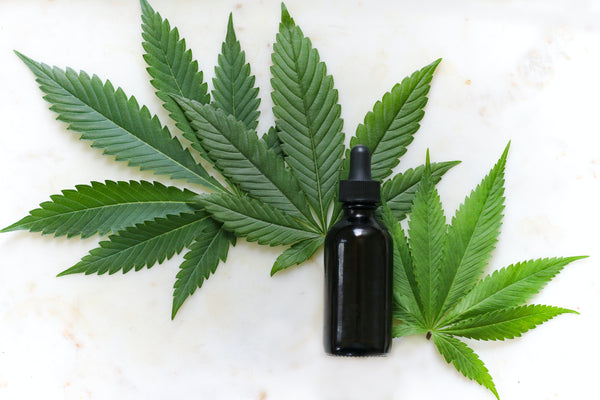CBD from Hemp vs. CBD from Marijuana

CBD has been the biggest three-letter buzzword in the food and dietary supplement industry. But where exactly does it come from? It’s not a simple answer as Cannabis sativa is a complex plant. It boasts two related species, hemp and marijuana, and contains over 400 chemical compounds, including the 113 identified cannabinoids. But the concentration of each compound is balanced differently between the two “types” of cannabis. And these different chemical concentrations create some important differences when discussing CBD derived from marijuana versus CBD from hemp.
So what exactly are the differences, and how do they compare?
Again, the answer isn’t so simple. While CBD is CBD, regardless of source, its presence alongside other cannabinoids can have a big impact on homeostasis. This is because of something called the “entourage effect,” which is the concept that all the compounds in cannabis work together to produce a multiplier effect.
The bottom line boils down to how these two cannabis cousins are treated legally, how the different compounds present in hemp v. marijuana impact the entourage effect, and with regards to use and application.
Join Bluebird Botanicals as we explore the implications of these differences between CBD derived from marijuana and CBD from hemp - and debunk the myth that one is superior.
What is CBD?
CBD stands for cannabidiol. It’s one of the “big six” cannabinoids that have been identified in medical research. As a cannabinoid, CBD readily impacts the body processes of vertebrates through something called the endocannabinoid system. This system is responsible for regulating our physiology, moods, and more. It also naturally produces its own cannabinoids, referred to as endogenous cannabinoids or endocannabinoids. These include the endocannabinoid anandamide, which is named after the Sanskrit word for “bliss.”
Where does CBD come from?
CBD, on the other hand, is not manufactured by the body. It does occur naturally in plants, making it a phytocannabinoid. CBD can come from many sources, including marijuana - which is also referred to as medical cannabis - and even seaweed. And then, of course, there is CBD derived from hemp, which is what Bluebird Botanicals uses.
Hemp has been called the “lesser-known cousin” of marijuana but in actuality it was once grown far and wide. It was mandated by law that the farmers in early colonial America grow hemp crops for use in making rope, clothes, ship sails, and other industrial goods. Like marijuana, hemp contains a plentiful spectrum of phytocannabinoids.
What’s the difference between CBD from Hemp and CBD from Marijuana?
The most notable difference between hemp and marijuana lies in the concentrations of cannabinoids. Hemp typically contains a much stronger concentration of CBD and less than 0.3% THC. Marijuana, by contrast, usually clocks in with 10% or more CBD and a minimum of 20% THC. And how these concentrations balance each other does impact the resulting effect.
Legally speaking
Different countries have different regulations and limits on the amount of THC that can be present as related to the dry weight of a crop. In the U.S., this means that hemp cannot contain more than 0.3% per pound of dry weight. The limit in Europe is even lower at 0.2%.
And the implications of the legal differences are pretty huge. CBD and industrial hemp are now federally legal in the U.S. - meaning most products can be produced and shipped nationwide - while any CBD produced from marijuana will face additional regulations and prohibitions, depending on the state or locality.
Related Article: Why Was Hemp Made Illegal?
Seeds, stalks, and flower
Another difference between the two sources of CBD is how farmers choose to grow and harvest the crop. Different parts of the plant tend to serve different purposes: seeds are often used in food and cosmetics, stalks for fibrous goods like clothing and building material, and flower or buds are typically harvested with an eye on cannabinoids.
While hemp typically uses the seeds and stalks (as well as the flower), marijuana relies on extracting primarily THC from the buds and flower to achieve that high cannabinoid content.
Resin also makes a difference
Another major difference between hemp plants and marijuana plants is resin content. Industrial hemp plants are low-resin plants, while its cannabis cousin marijuana is typically higher in resin.
Many industrial hemp crops consist of skinny, bamboo-like plants. These plants are especially good for producing products like paper, cloth, bioplastic, biofuel, and more. Hemp seeds can also be pressed into hemp seed oil, which is highly nutritious and easy to incorporate into any diet.
Marijuana, in contrast, typically yields one to two bushy plants per square meter, and its flowers are hand-harvested, dried, trimmed, and cured. The flowers are then consumed for their intoxicating and medicinal effects.
The hemp plants Bluebird Botanicals uses for our CBD products more closely resemble their thicker, resin-rich marijuana cousins, making our hemp especially well-suited for extracting CBD.
So, what exactly does that mean for your CBD?
CBD From Marijuana
Characteristics at a glance:
- Typically contains high levels of THC in conjunction with moderate levels of CBD
- Can contain a high cannabinoid content in a small serving size, particularly of THC
- Can be found in many varieties and strains with varying flavors, percentages, and more
- Faces more stringent legal regulations because of the higher concentrations of psychoactive THC
- May potentially cause psychoactive side-effects, depending on the person and serving size, because of the prevalence of THC
Hemp CBD
Characteristics at a glance:
- Typically contains higher levels of CBD and always must maintain THC levels below 0.3% by dry weight
- Is legal in all 50 states in the U.S., thanks to the 2018 Farm Bill
- Has a greater prevalence of options for consumption, including via flavored oils, e-juices, tinctures, topicals and more
- Contains a small enough amount of THC that the vast majority of users do not experience any psychoactive effects
Not all CBD from hemp is trustworthy
“CBD is CBD. The human body does not care where the molecule comes from.”
Franjo Grotenhermen, the former Chairman of the International Association For Cannabinoid Medicines
While this may be true, it’s important that those interested in CBD make sure to read the label. You’ll want to select a product that showcases its quality and transparency through third-party lab testing on all batches of product. This will allow you to confirm that the amounts of CBD and other cannabinoids present match what you are intending to put in or on your body.
Which do you choose?
That decision is entirely up to you.
It’s clear that the quality of the CBD molecule doesn’t differ, no matter whether it is CBD derived from marijuana or CBD from hemp. That being said, the other compounds and qualities of each of the cannabis plants in combination with CBD can have varying effects. Choose the option that is best tailored to your lifestyle and desired effects and be sure to do your research on the reputability of the company to confirm what’s in your bottle matches their advertising claims.
It’s also important to remember that certain municipalities may prevent you from accessing CBD that isn’t derived from hemp. So be sure to evaluate your local laws and make sure you’re choosing something appropriate not only for how you want to feel but that is also allowable where you live.
As a reminder, CBD from hemp is legal nationwide in the U.S.
Still have questions? The Bluebird Botanicals Customer Care Team is here for you! Reach out to us at info@BluebirdBotanicals.com and let us guide you to wellness.










